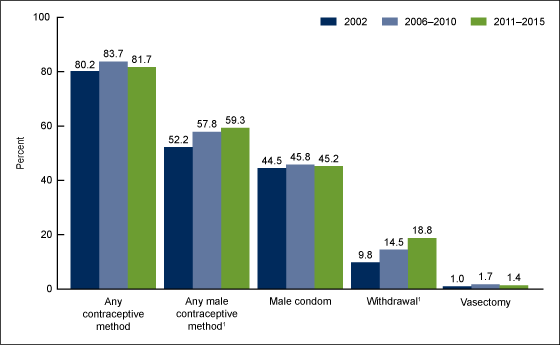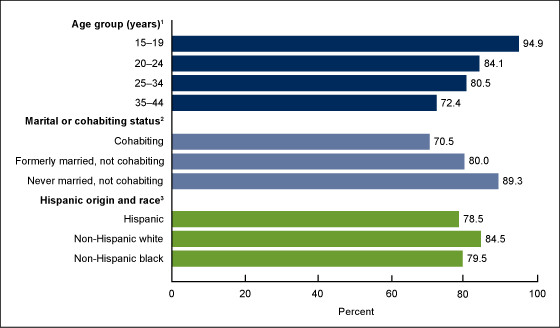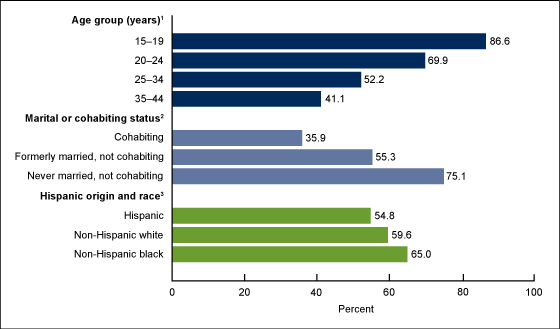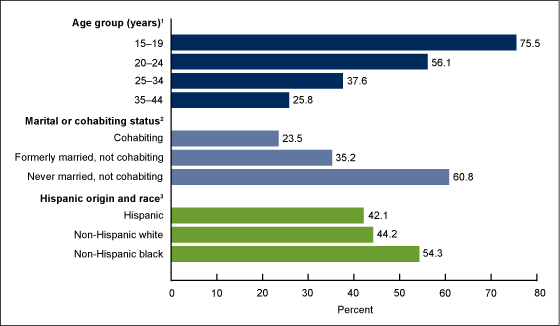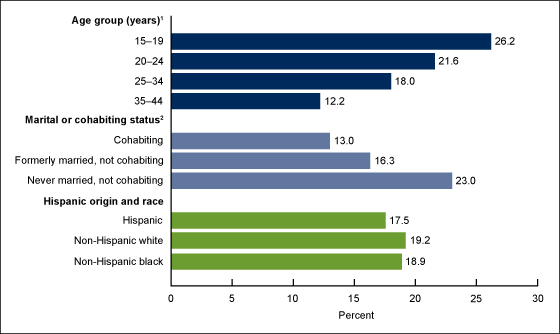Unmarried Men’s Contraceptive Use at Recent Sexual Intercourse: United States, 2011–2015
- Key findings
- Use of male methods overall and withdrawal increased over time, while use of other methods remained similar.
- Use of any contraceptive method varied by age, marital or cohabiting status, and Hispanic origin and race.
- Use of any male method varied by age, marital or cohabiting status, and Hispanic origin and race.
- Use of the male condom varied by age, marital or cohabiting status, and Hispanic origin and race.
- Use of withdrawal varied by age and marital or cohabiting status, but no differences were seen by Hispanic origin and race.
- Summary
- Definitions
- Data source and methods
- About the authors
- References
- Suggested citation
NCHS Data Brief No. 284, August 2017
PDF Versionpdf icon (495 KB)
Kimberly Daniels, Ph.D., and Joyce C. Abma, Ph.D.
Key findings
Data from the National Survey of Family Growth
- In 2011–2015, 81.7% of unmarried men who had sexual intercourse in the last 3 months reported that they or their female partner used any method of contraception at last sexual intercourse.
- Nearly 60% of unmarried men reported using any male method of contraception at recent sexual intercourse in 2011–2015; 45.2% reported using the male condom.
- Use of withdrawal increased over the three time points shown here: 2002, 2006–2010, and 2011–2015.
- Higher percentages of younger unmarried men used any method, any male method, the male condom, and withdrawal at recent sexual intercourse compared with older men.
- A higher percentage of unmarried non-Hispanic black men used the male condom compared with Hispanic and non-Hispanic white men.
Contraception is used to help prevent unintended pregnancies and sexually transmitted infections (STI). Higher percentages of pregnancies to unmarried persons are unintended than for those who are married (1). Patterns of contraceptive use as reported by women, including differences by marital status, are well documented using National Survey of Family Growth (NSFG) data (2–4); however, less research focuses on contraceptive use as reported by men. Using 2011–2015 NSFG data from men, with selected time trends, this data brief describes contraceptive use at last recent vaginal sexual intercourse (within 3 months) among unmarried men, focusing primarily on male methods of contraception (condom, withdrawal, and vasectomy).
Keywords: condom, withdrawal, National Survey of Family Growth
Use of male methods overall and withdrawal increased over time, while use of other methods remained similar.
- Among unmarried men who had sexual intercourse in the last 3 months, no change was seen in the percentages reporting that they or their partner used any method of contraception at last sexual intercourse across the three time points shown: 80.2% in 2002, 83.7% in 2006–2010, and 81.7% in 2011–2015 (Figure 1).
- The percentage of unmarried men who had sexual intercourse in the last 3 months who used a male method of contraception during last sexual intercourse increased from 52.2% in 2002 to 59.3% in 2011–2015.
- No differences were seen across the three time points in condom use (44.5%–45.8%) or vasectomy (1.0%–1.7%).
- Use of withdrawal nearly doubled from 9.8% in 2002 to 18.8% in 2011–2015.
Figure 1. Percentage using any and selected contraceptive methods at last sexual intercourse among unmarried men aged 15–44 who had intercourse in the last 3 months: United States, 2002, 2006–2010, and 2011–2015
1Significant linear trend, p < 0.05.
NOTES: Any contraceptive method includes all methods used by men and their female partners. Any male contraceptive method includes male condom, withdrawal, and vasectomy. Access data table for Figure 1pdf icon.
SOURCE: NCHS, National Survey of Family Growth, 2002, 2006–2010, 2011–2015.
Use of any contraceptive method varied by age, marital or cohabiting status, and Hispanic origin and race.
- Among unmarried men who had sexual intercourse in the last 3 months, use of any contraceptive method decreased with increasing age groups, ranging from 94.9% of men aged 15–19 to 72.4% of men aged 35–44 (Figure 2).
- Use of any method of contraception was highest among never-married men (89.3%), followed by formerly married (80.0%) and cohabiting (70.5%) men.
- Use of any method of contraception was higher for non-Hispanic white men (84.5%) compared with Hispanic (78.5%) and non-Hispanic black men (79.5%).
Figure 2. Percentage using any method of contraception at last sexual intercourse among unmarried men aged 15–44 who had intercourse in the last 3 months, by selected characteristics: United States, 2011–2015
1Significant linear trend, p < 0.05.
2Significant difference across the three comparison groups, p < 0.05.
3Significant differences between non-Hispanic white men and all other Hispanic-origin and race groups, p < 0.05.
NOTES: Any method of contraception includes all methods used by men and their female partners. See Definitions on Hispanic origin and race for more details on single and multiple-race coding. Access data table for Figure 2pdf icon.
SOURCE: NCHS, National Survey of Family Growth, 2011–2015.
Use of any male method varied by age, marital or cohabiting status, and Hispanic origin and race.
- Among unmarried men who had sexual intercourse in the last 3 months, use of any male method at last intercourse decreased with increasing age (Figure 3).
- Use of any male method was highest among never-married men (75.1%), followed by formerly married (55.3%) and cohabiting (35.9%) men.
- Use of any male method was higher for non-Hispanic black men (65.0%) compared with Hispanic men (54.8%).
Figure 3. Percentage using any male method of contraception at last sexual intercourse among unmarried men aged 15–44 who had intercourse in the last 3 months, by selected characteristics: United States, 2011–2015
1Significant linear trend, p < 0.05.
2Significant difference across the three comparison groups, p < 0.05.
3Significant difference for non-Hispanic black men and Hispanic men, p < 0.05.
NOTES: Any male method of contraception includes male condom, withdrawal, and vasectomy. See Definitions on Hispanic origin and race for more details on single and multiple-race coding. Access data table for Figure 3pdf icon.
SOURCE: NCHS, National Survey of Family Growth, 2011–2015.
Use of the male condom varied by age, marital or cohabiting status, and Hispanic origin and race.
- Among unmarried men who had sexual intercourse in the last 3 months, use of the condom decreased with increasing age groups, ranging from 75.5% among those aged 15–19 to 25.8% among those aged 35–44 (Figure 4).
- Use of the male condom was highest among never-married men (60.8%), followed by formerly married men (35.2%) and cohabiting men (23.5%).
- A higher percentage of non-Hispanic black men used condoms at their last sexual intercourse (54.3%) compared with non-Hispanic white (44.2%) and Hispanic (42.1%) men.
Figure 4. Percentage using a male condom at last sexual intercourse among unmarried men aged 15–44 who had intercourse in the last 3 months, by selected characteristics: United States, 2011–2015
1Significant linear trend, p < 0.05.
2Significant difference across the three comparison groups, p < 0.05.
3Significant differences between non-Hispanic black men and all other Hispanic-origin and race groups, p < 0.05.
NOTES: See Definitions on Hispanic origin and race for more details on single and multiple-race coding. Access data table for Figure 4pdf icon.
SOURCE: NCHS, National Survey of Family Growth, 2011–2015.
Use of withdrawal varied by age and marital or cohabiting status, but no differences were seen by Hispanic origin and race.
- Among unmarried men who had sexual intercourse in the last 3 months, use of withdrawal decreased with increasing age groups, ranging from 26.2% among men aged 15–19 to 12.2% among men aged 35–44 (Figure 5).
- Use of withdrawal was higher for never-married men (23.0%) compared with formerly married (16.3%) and cohabiting (13.0%) men.
- Use of withdrawal was similar across the Hispanic-origin and race groups shown, around 18%–19%.
Figure 5. Percentage using withdrawal at last sexual intercourse among unmarried men aged 15–44 who had intercourse in the last three months, by selected characteristics: United States, 2011–2015
1Significant linear trend, p < 0.05.
2Significant difference between never-married men and cohabiting and formerly married men, p < 0.05.
NOTES: See Definitions on Hispanic origin and race for more details on single and multiple-race coding. Access data table for Figure 5pdf icon.
SOURCE: NCHS, National Survey of Family Growth, 2011–2015.
Summary
In 2011–2015, among unmarried men aged 15–44 who had sexual intercourse in the last 3 months, 81.7% used a method of contraception at last intercourse. Nearly 60% reported using a male method of contraception at last intercourse (condom, withdrawal, or vasectomy). Male condoms were used by 45.2% of men at last intercourse, a percentage statistically unchanged from 2006–2010 (45.8%) and 2002 (44.5%). Use of withdrawal increased over these three time points, to 18.8% in 2011–2015.
Higher percentages of younger unmarried men used any method, any male method, the male condom, and withdrawal at recent sexual intercourse compared with unmarried men of older ages. Across marital and cohabiting status, the percentage of men using any method, any male method, and the male condom was highest for never-married men, followed by formerly married and currently cohabiting men. A higher percentage of unmarried non-Hispanic black men used any male method compared with unmarried Hispanic men. In addition, a higher percentage of unmarried non-Hispanic black men used the male condom compared with all other Hispanic-origin and race groups shown in this report.
Compared with married men and women, higher percentages of pregnancies to unmarried men and women are unintended (1). About one-half of new STIs occur among those aged 15–24 (5), an age group in which most are unmarried (6). The bulk of research on contraceptive use has relied on data collected from women. It is potentially useful to examine men’s reports of contraceptive method use, particularly for the use of male methods, because different patterns may be seen among men compared with women. Additional NSFG data are available to allow further analyses of contraceptive use as reported by men.
Definitions
Age: Respondent’s age at the time of the interview. The NSFG recode variable used was AGER.
Contraceptive use at recent sexual intercourse: Contraceptive method(s) used at the respondent’s last sexual (vaginal) intercourse occurring in the last 3 months. The male condom, withdrawal, and vasectomy are described here as male methods of contraception because they require action on the part of the male partner, unlike other methods that involve action only by the female partner (e.g., oral contraceptive pills). One or both partners may be involved in contraceptive decision-making regardless of the methods used. The residual percentages of men not using any method of contraception do not necessarily indicate risk of an unintended pregnancy. The NSFG recodes used were METH3M1–METH3M4, which are based on men who had sexual intercourse with a female partner within the last 3 months.
Hispanic origin and race: The Office of Management and Budget’s 1997 guidelines for the presentation of race and origin data in federal statistics are used for the classifications in this report (7). These guidelines allowing respondents to report more than one racial or ethnic origin are reflected in the NSFG recode variable HISPRACE2. For this report, the categories shown separately are Hispanic; non-Hispanic white, single race; and non-Hispanic black, single race. Non-Hispanic other respondents were included in overall estimates but are not shown separately due to the diversity of this group. For ease of writing, non-Hispanic white, single race is referred to as non-Hispanic white; and non-Hispanic black, single race is referred to as non-Hispanic black.
Marital or cohabiting status: Respondent’s marital or cohabiting status at the time of the interview with regard to opposite-sex partners. Categories considered here as unmarried are cohabiting, formerly married (widowed, divorced, or separated for reasons of marital discord), and never married. Marital status is defined in this report based on the respondent’s current status regardless of his previous marital status (e.g., if a respondent was formerly married but cohabiting at the time of interview, he was classified as cohabiting in this report.). The NSFG recode used was RMARITAL.
Data source and methods
This report is based primarily on interview data from the 3,707 unmarried men aged 15–44 in the combined 2011–2013 and 2013–2015 NSFG data files who had sexual intercourse in the 3 months before the interview. Information from the 2002 and 2006–2010 NSFG data files is also used in Figure 1. NSFG is a nationally representative survey of women and men aged 15–44 in the U.S. household population that gathers data on fertility, marriage, divorce, infertility, use of contraception, and general and reproductive health. More information is available on the NSFG website: https://www.cdc.gov/nchs/nsfg/index.htm.
Statistics for this report were produced using the SURVEY procedures in SAS software version 9.4. Percentages were compared using two-tailed t tests at the 5% level. No adjustments were made for multiple comparisons. A weighted least-squares regression was used to test for linear trends across age groups and time periods. The data presented in this report are bivariate associations that may be explained by other factors included and not included in this report. For example, given that never-married men are typically younger than cohabiting and formerly married men, differences seen here by marital or cohabiting status may be partly explained by age differences across groups. Vasectomy was not presented separately in this report after Figure 1 because many of the numbers were too small to be statistically reliable. Percentages reflect use either alone or in combination with another method at recent sexual intercourse.
About the authors
Kimberly Daniels and Joyce C. Abma are with the National Center for Health Statistics, Division of Vital Statistics, Reproductive Statistics Branch.
References
- Finer LB, Zolna MR. Declines in unintended pregnancy in the United States, 2008–2011. N Engl J Med 374(9):843–52. 2016.
- Chandra A, Martinez GM, Mosher WD, et al. Fertility, family planning, and reproductive health of U.S. women: Data from the 2002 National Survey of Family Growthpdf icon. National Center for Health Statistics. Vital Health Stat 23(25). 2005.
- Daniels K, Mosher WD, Jones J. Contraceptive methods women have ever used: United States, 1982–2010pdf icon. National health statistics reports; no 62. Hyattsville, MD: National Center for Health Statistics. 2013.
- Daniels K, Daugherty J, Jones J, Mosher W. Current contraceptive use and variation by selected characteristics among women aged 15–44: United States, 2011–2013pdf icon. National health statistics reports; no 86. Hyattsville, MD: National Center for Health Statistics. 2015.
- CDC. Information for teens and young adults: Staying healthy and preventing STDspdf icon. CDC Fact Sheet. 2014.
- Copen CE, Daniels K, Vespa J, Mosher WD. First marriages in the United States: Data from the 2006–2010 National Survey of Family Growthpdf icon. National health statistics reports; no 49. Hyattsville, MD: National Center for Health Statistics. 2012.
- Office of Management and Budget. Revisions to the standards for the classification of federal data on race and ethnicityexternal icon. Fed Regist 62(210):58782–90. 1997.
Suggested citation
Daniels K, Abma JC. Unmarried men’s contraceptive use at recent sexual intercourse: United States, 2011–2015. NCHS data brief, no 284. Hyattsville, MD: National Center for Health Statistics. 2017.
Copyright information
All material appearing in this report is in the public domain and may be reproduced or copied without permission; citation as to source, however, is appreciated.
National Center for Health Statistics
Charles J. Rothwell, M.S., M.B.A., Director
Jennifer H. Madans, Ph.D., Associate Director for Science
Division of Vital Statistics
Delton Atkinson, M.P.H., M.P.H., P.M.P., Director
Hanyu Ni, Ph.D., M.P.H., Associate Director for Science
